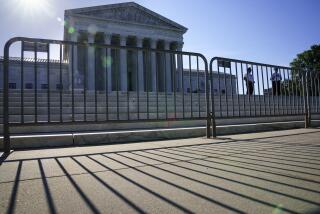Supreme Court leaned right on many issues this term
- Share via
WASHINGTON — The Supreme Court, now the lone branch of government dominated by Republican appointees, continued this year to lean to the right on matters of race, crime, the environment and campaign funding.
But the just-completed term, which began amid last fall’s collapse on Wall Street, also saw a tilt to the left and away from the George W. Bush administration’s hands-off policy toward business. Reversing the recent trend, the justices this year cleared the way for consumer-driven lawsuits against banks and the makers of drugs and cigarettes.
Overall, the court remained closely divided in a year in which neither the conservative nor liberal bloc could claim major wins. Now the justices will be on recess for two months, while the Senate decides whether to approve President Obama’s first nominee to the court.
If Judge Sonia Sotomayor is confirmed as expected, she will take her seat in early September, just in time to hear a potentially momentous case on whether corporations have the right to spend freely to influence elections.
Before this year, Justice Anthony M. Kennedy and the court’s conservatives had handed down a series of pro-business rulings. They made it much harder for cheated investors to sue companies for stock frauds. They protected makers of medical devices from being sued by patients when the products proved defective. In 2007, they shielded thousands of mortgage lenders from being sued by state attorneys general who had accused them of luring consumers with deceptive loans. The Bush administration said these lenders were subject only to federal regulation.
But the housing crisis, the Wall Street collapse and the Bernard L. Madoff scandal exposed the weakness of the federal government’s regulation of business. And this year, the court sounded quite a different note.
Its most significant business case was heard the same week as the November election. At issue was whether drug makers were shielded from being sued by injured patients. Bush administration lawyers had supported the drug makers and said that federal regulations trumped state consumer-protection laws. The plaintiff, Diana Levine, had an arm amputated after she was injected with a federally approved anti-nausea drug with a history of causing gangrene.
In Wyeth vs. Levine, the court’s liberal bloc, joined by Kennedy, rejected the shield for the drug makers and upheld the consumer’s right to sue. In a parallel ruling, the court said that federal warning labels did not shield tobacco firms from being sued for falsely advertising “light” cigarettes.
And on the final day of the term, the court ruled 5 to 4 in favor of the 50 state attorneys general, saying that they could enforce their consumer-protection laws against national banks.
If there is one thing corporations like less than lawsuits, it is allowing angry juries to punish companies with huge verdicts. Retiring Justice David H. Souter had joined a series of 5-4 decisions that put limits on large punitive damages against corporations. Last year, he wrote the opinion that slashed the $2.5-billion punitive damages against Exxon for the Exxon Valdez oil spill in Alaska.
Souter’s retirement could prove a crucial loss for business. They could now face a court more willing to allow juries and plaintiffs’ lawyers to mete out punishment to corporate wrongdoers.
On race and civil rights, the court remained closely divided. The conservative bloc, joined by Kennedy, prevailed in three rulings that limited civil rights laws involving the use of race.
A pair of rulings scaled back parts of the Voting Rights Act. One 5-4 decision eased the pressure on state officials to create voting districts likely to elect black or Latino candidates. The second ruling narrowed part of the act. The justices said that municipalities with clean records regarding the Voting Rights Act could escape Justice Department scrutiny when they changed their election procedures.
Meanwhile, a ruling in favor of white firefighters will ease pressure on employers whose hiring or promotional policies appear to exclude minorities.
Before, statistics could fuel a lawsuit against an employer whose hiring or promotional standards had a “disparate impact” on blacks or Latinos. But in Ricci vs. DeStefano, the 5-4 majority recalibrated that rule and said that employers should not throw out the scores from a promotional test “based solely on the racial disparity in the results.”
Business also won another key job discrimination case making it much harder for older workers to win claims of age bias. Typically in these cases, an employee who is laid off or demoted says he has some evidence that his age was a motivating factor. Usually, judges would then require the employer to show a valid reason for the demotion or layoff.
But in Gross vs. FBL Financial Services, a 5-4 majority rejected this “mixed motives” approach and said the worker bears the full burden of proving he was a victim of age bias. “The burden of persuasion does not shift to the employer,” said Justice Clarence Thomas, “even when the plaintiff has produced some evidence that age was a motivating factor.”
“The real-world impact of this decision is to effectively repeal the age-discrimination law for millions of American workers,” said Simon Lazarus, a lawyer for the National Senior Citizens Law Center.
On Monday, the conservative bloc also served notice that it may be ready to knock down the campaign finance laws that limit spending by corporations. On Sept. 9, the court will hear arguments on whether to overrule its precedents in this area.
The case sets the stage for the first showdown between the Obama administration and the Roberts court. And to add to the drama, it could be the first day on the bench for Justice Sotomayor.
--
More to Read
Get the L.A. Times Politics newsletter
Deeply reported insights into legislation, politics and policy from Sacramento, Washington and beyond. In your inbox three times per week.
You may occasionally receive promotional content from the Los Angeles Times.











